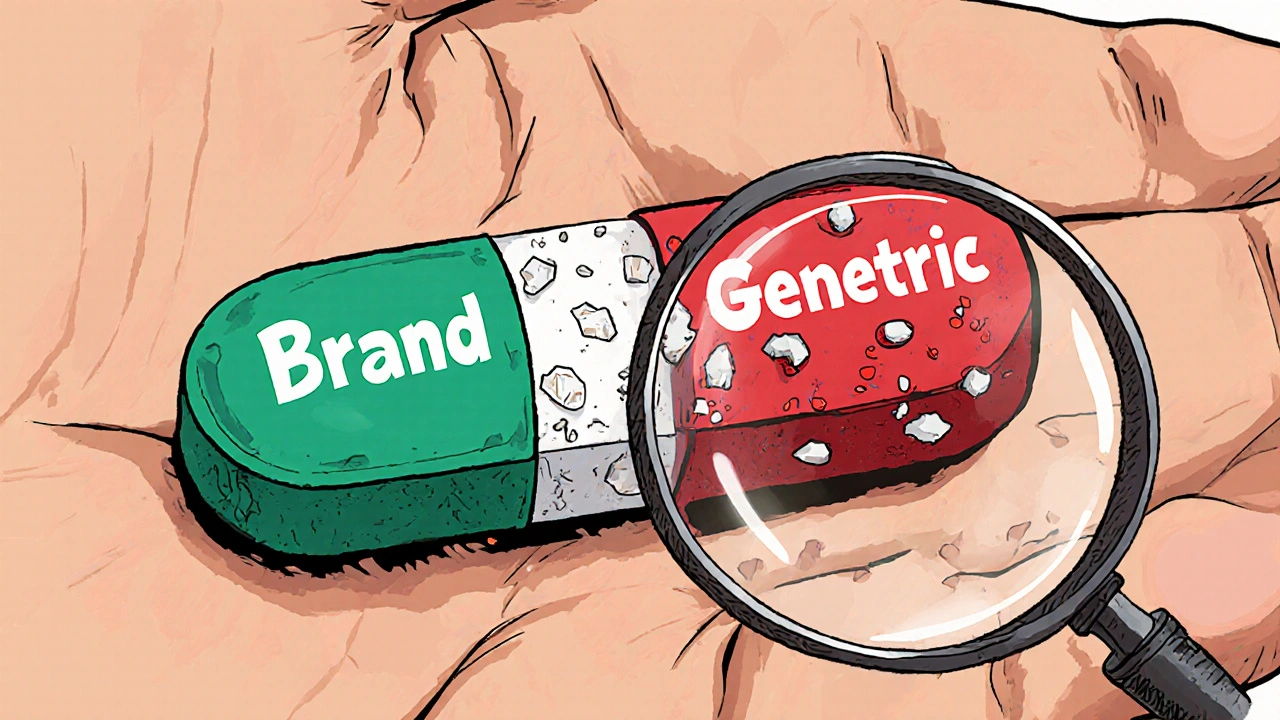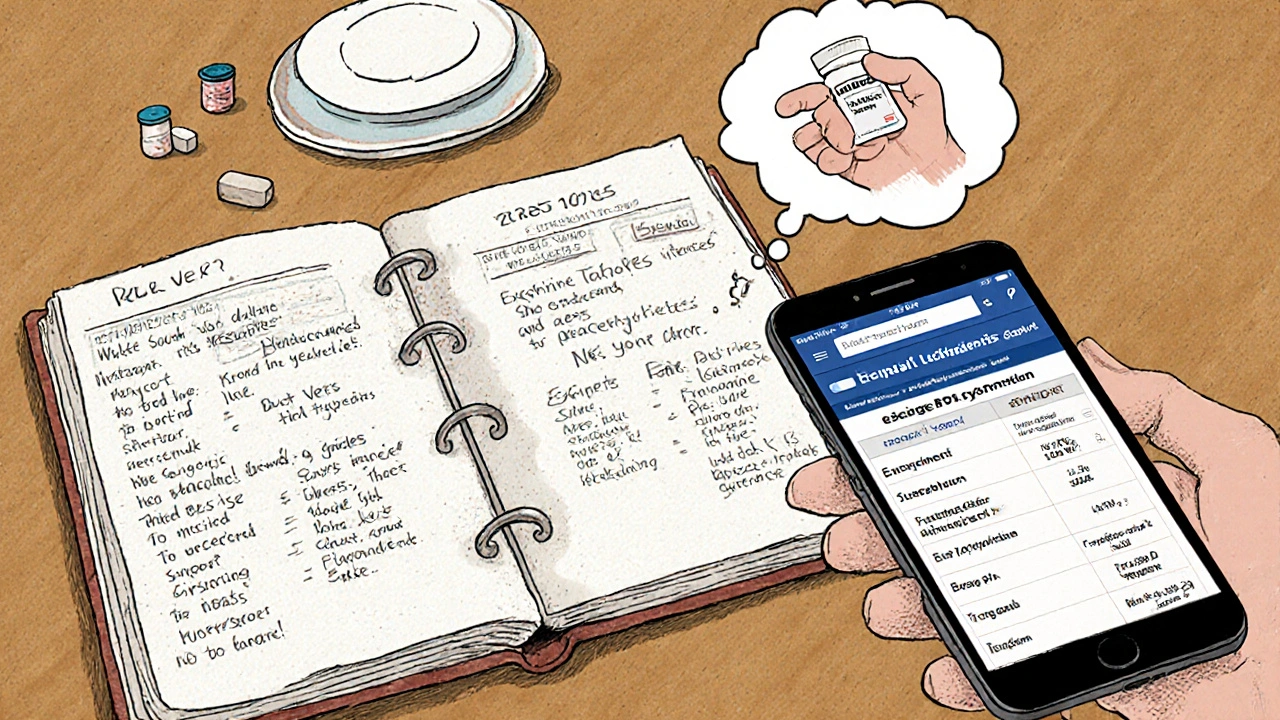Brand vs Generic Medications: Excipients and Side Effect Intolerances

Generic Medication Excipient Checker
Check if your generic medication may contain excipients you're sensitive to. Based on common ingredients found in medications.
Results
Most people assume that a generic medication is just a cheaper copy of the brand-name version-and for the most part, they’re right. The active ingredient is the same. The dose is the same. The pill looks different, sure, but it’s supposed to work the same way. And for about 92% of patients, it does. But for the other 8%, something goes wrong. Not because the medicine doesn’t work-but because of what’s not in the active ingredient. The excipients.
What Are Excipients, Really?
Excipients are the non-active ingredients in a pill. Think of them as the scaffolding, the glue, the coating, the filler. They help the medicine hold its shape, dissolve at the right speed, taste better, or last longer on the shelf. Common ones include lactose, cornstarch, titanium dioxide, croscarmellose sodium, and artificial dyes like FD&C Red No. 40. These aren’t meant to treat anything. They’re just there to make the drug work as a product. Here’s the catch: while the FDA requires brand and generic drugs to have identical active ingredients, they don’t require identical excipients. A generic version of your blood pressure pill might use lactose as a filler. The brand version? It uses mannitol. If you’re lactose intolerant, that tiny difference can mean bloating, cramps, or worse. And you won’t see it on the label.Why Do Generic Drugs Differ in Excipients?
Generic manufacturers don’t have to copy the brand’s exact formula. They just need to prove their version delivers the same amount of active ingredient into your bloodstream within a certain range-usually 80% to 125% of the brand’s bioavailability. That’s called bioequivalence. For most drugs, that’s plenty close enough. But for drugs with a narrow therapeutic index-like warfarin, levothyroxine, or levodopa-even a small change in how fast the pill dissolves can throw your levels off. That’s where excipients matter. A different binder might slow down how quickly the tablet breaks apart in your stomach. A different coating might change how it’s absorbed. A different dye might trigger an allergic reaction in someone who’s sensitive. One patient switched from branded Sinemet to a generic levodopa/carbidopa and suddenly couldn’t get out of bed for days. Their doctor blamed “noncompliance.” But it turned out the generic used a different starch that delayed absorption-just enough to make the difference between movement and stiffness.Who’s Most at Risk?
Not everyone needs to worry. But if you fall into any of these groups, pay attention:- People with known allergies or intolerances: Lactose, gluten, soy, or dye allergies can trigger reactions from generics. One study found patients with celiac disease had worse symptoms after switching to a generic thyroid med containing lactose.
- Patients on narrow therapeutic index (NTI) drugs: These are drugs where the line between effective and toxic is thin. Warfarin, digoxin, phenytoin, levothyroxine, and some epilepsy meds fall here. A 2022 JAMA study showed that for these drugs, even small absorption differences led to measurable clinical changes.
- Chronic illness patients with sensitive systems: Parkinson’s patients, transplant recipients on immunosuppressants, and people with autoimmune disorders often report noticeable changes after switching. The Michael J. Fox Foundation’s 2023 survey found 18% of Parkinson’s patients had worse symptoms after switching to generic levodopa.
- People who’ve had bad reactions to a specific generic: If you’ve ever felt nauseous, dizzy, or “off” after a refill change, it’s not all in your head. Document it.

Real Stories, Real Problems
Reddit threads and patient forums are full of these stories. One woman with atrial fibrillation switched from a brand-name antiarrhythmic to a generic and started having palpitations. She went back to the brand-and they vanished. The generic contained lactose; she was undiagnosed lactose intolerant. Another man with epilepsy had seizures after switching generics. His neurologist dismissed it. He kept a log. The seizures always happened after the pharmacy switched to a different generic manufacturer. He switched back to the brand-and stayed seizure-free for two years. These aren’t rare. The Institute for Safe Medication Practices found that 40% of adverse events tied to generic substitutions were due to excipients, not the active drug. And most patients don’t know how to ask about them.How to Protect Yourself
You don’t have to avoid generics. But you do need to be smart.- Ask your pharmacist. They have access to the full ingredient list. Ask: “Does this generic contain lactose, gluten, or FD&C dyes?” Don’t assume they’ll tell you unless you ask.
- Check the package insert. It’s often tucked inside the box. Look for “inactive ingredients.” If you don’t see it, call the manufacturer. Most list their excipients online.
- Stick with the same manufacturer. Generic companies change formulations. If you’ve had no issues with a certain brand of generic (say, Teva or Mylan), keep getting that one. Don’t let the pharmacy switch you without telling you.
- Ask your doctor to write “Dispense as Written” or “Do Not Substitute.” It’s legal. It’s your right. Insurance might charge you more, but your health matters more.
- Keep a medication diary. Note when you switch, what symptoms appear, and when they go away. Bring it to your next appointment.

What’s Changing?
The system is waking up. In 2024, the FDA announced plans to launch a public database listing excipients for both brand and generic drugs. That’s huge. For the first time, patients will be able to look up whether their generic contains a dye they’re allergic to. Generic manufacturers are also starting to compete on “clean excipient profiles.” One company now markets its generic levothyroxine as “lactose-free and dye-free,” targeting patients who’ve had bad experiences. It’s early, but it’s a sign things are shifting.Bottom Line: Generics Are Great-But Not One-Size-Fits-All
Generics save the U.S. healthcare system over $370 billion a year. They’re safe and effective for most people. But they’re not magic. The same pill, made by a different company, with different fillers, can behave differently in your body. If you’ve ever felt “worse” after a refill, it’s worth investigating. Don’t assume it’s just your condition flaring up. Ask questions. Demand transparency. Your body knows the difference-even if the label doesn’t.Frequently Asked Questions
Are generic medications less effective than brand-name drugs?
For most people, yes-generics work just as well. The FDA requires them to be bioequivalent, meaning they deliver the same amount of active ingredient into your bloodstream within a narrow range. Studies show 92% of generics perform the same as brand-name drugs across 47 drug classes. But for a small group-especially those on narrow therapeutic index drugs or with excipient sensitivities-differences in how the pill breaks down can affect effectiveness.
Can excipients in generics cause allergic reactions?
Yes. While rare, excipients like lactose, gluten, dyes (like FD&C Red No. 40), and preservatives can trigger allergic or intolerance reactions. One documented case involved a patient who developed severe gastrointestinal symptoms after switching to a generic thyroid medication containing lactose, despite being lactose intolerant. Another had an allergic reaction to a dye in a generic blood pressure pill. These reactions don’t come from the active drug-they come from the filler.
How do I know what excipients are in my medication?
Check the package insert that comes with your prescription. It lists all inactive ingredients. If you don’t have it, ask your pharmacist or search the manufacturer’s website. The FDA is working on a public database to make this easier, but it’s not fully live yet. Don’t rely on the pill bottle-it rarely lists excipients.
Should I avoid generics if I have a chronic illness?
Not necessarily. But if you’re on a drug with a narrow therapeutic index-like levothyroxine, warfarin, or levodopa-or if you’ve had a reaction to a generic before, be cautious. Talk to your doctor and pharmacist. Stick with the same generic manufacturer if it works for you. Don’t let your pharmacy switch you without warning.
Can my doctor force the pharmacy to give me the brand-name drug?
Yes. Your doctor can write “Dispense as Written” or “Do Not Substitute” on your prescription. Insurance may charge you more, but you have the right to request the brand if you’ve had issues with generics. Many patients with autoimmune conditions, epilepsy, or Parkinson’s do this successfully.
Why don’t pharmacies tell me when they switch my generic?
Pharmacies often switch generics to get the lowest price from their supplier. They’re not required to notify you unless you ask. That’s why it’s important to check your pills each time you refill. If they look different-color, shape, markings-ask if it’s the same manufacturer. Don’t assume it’s the same.